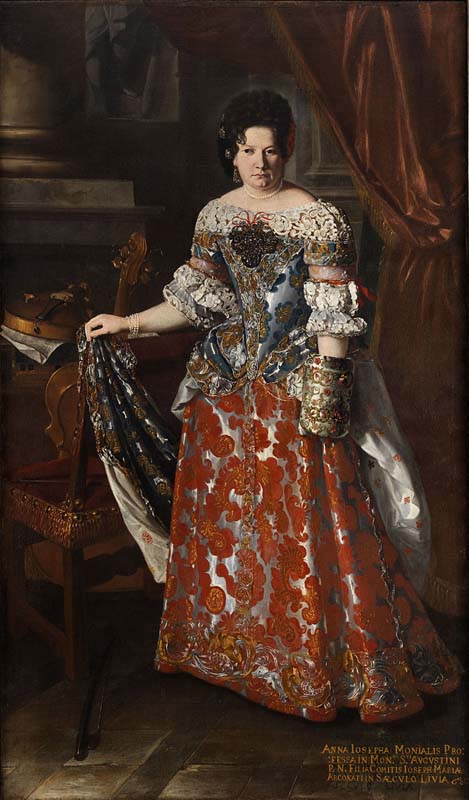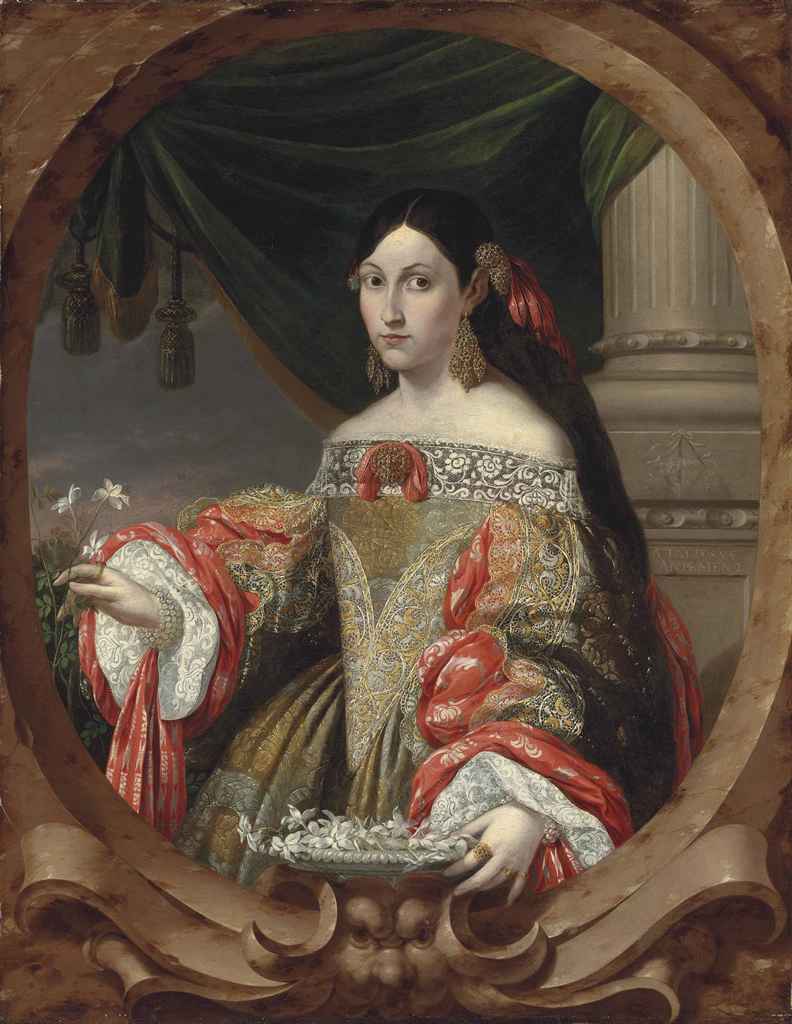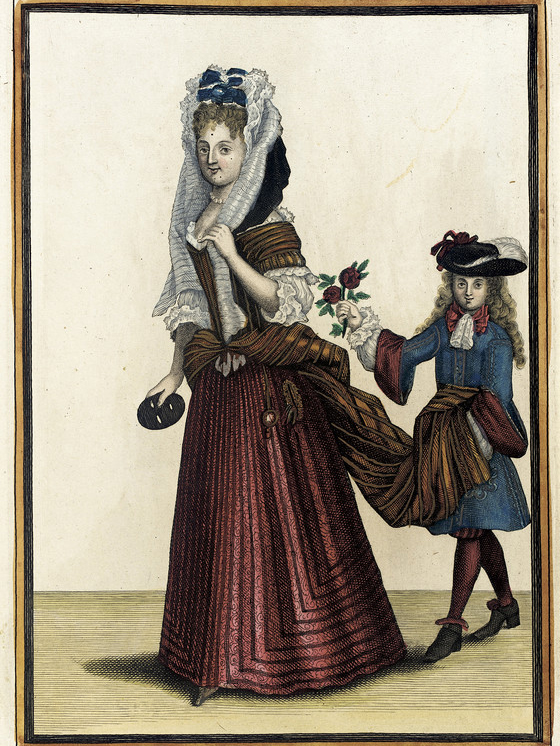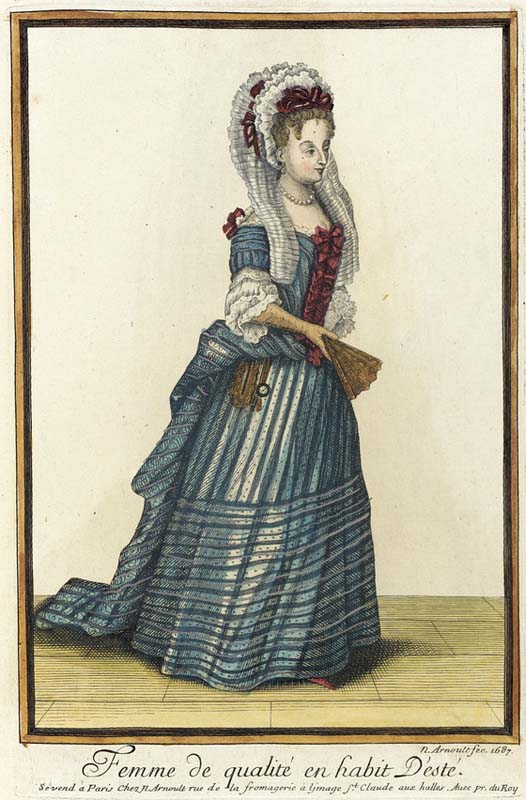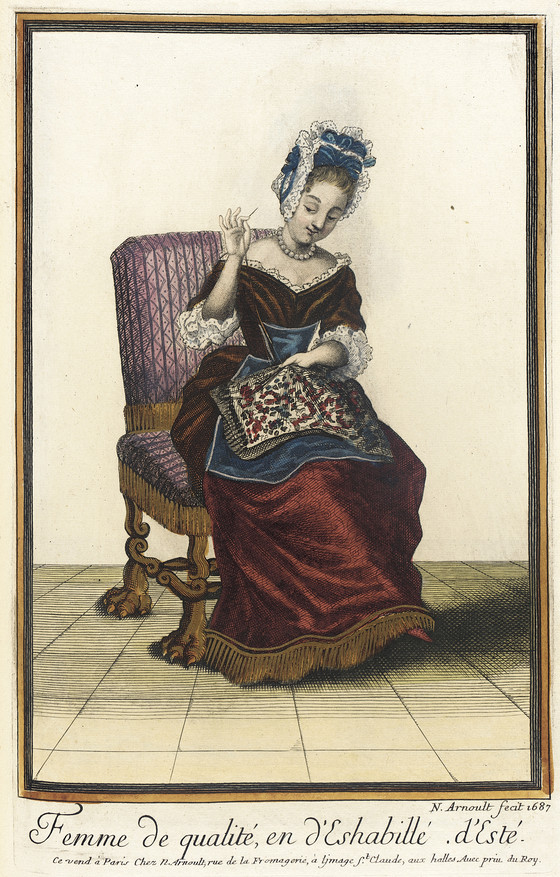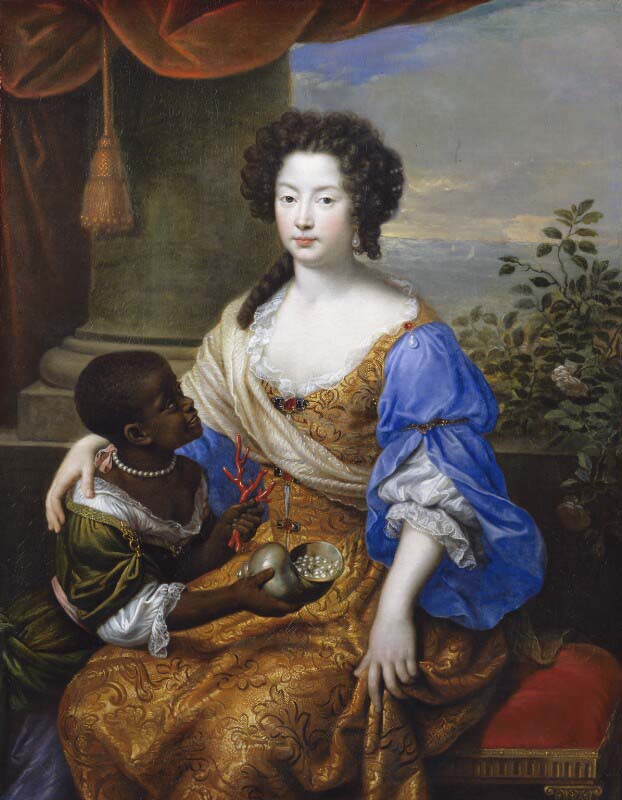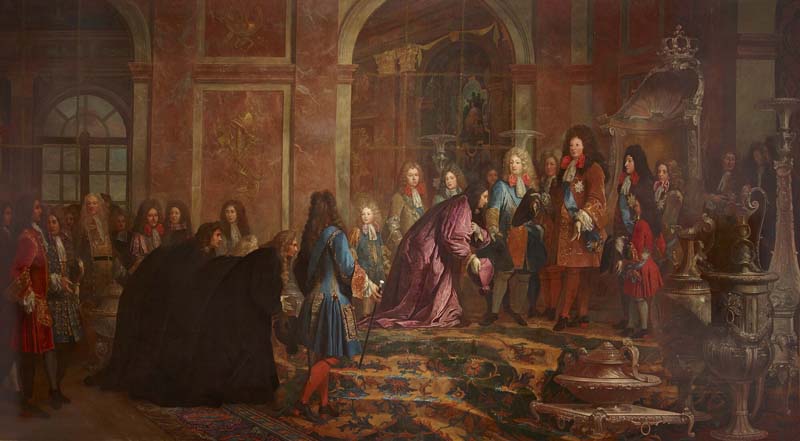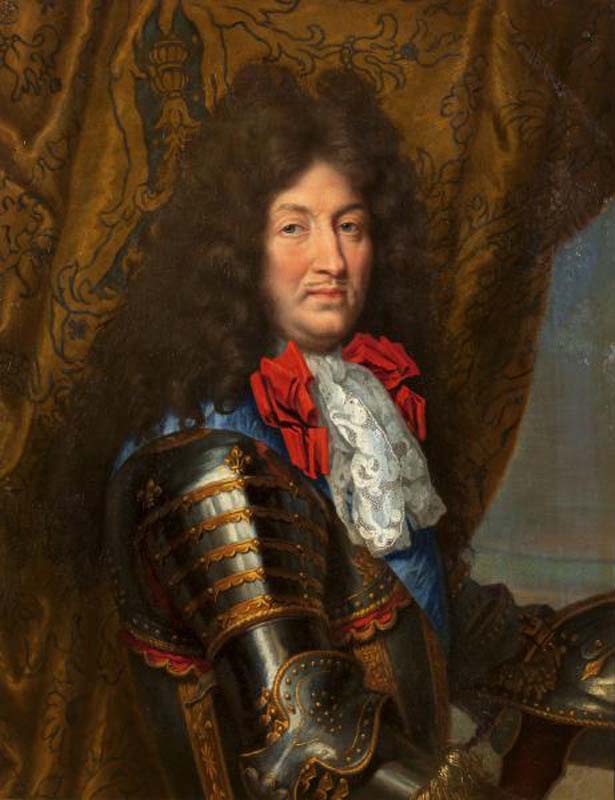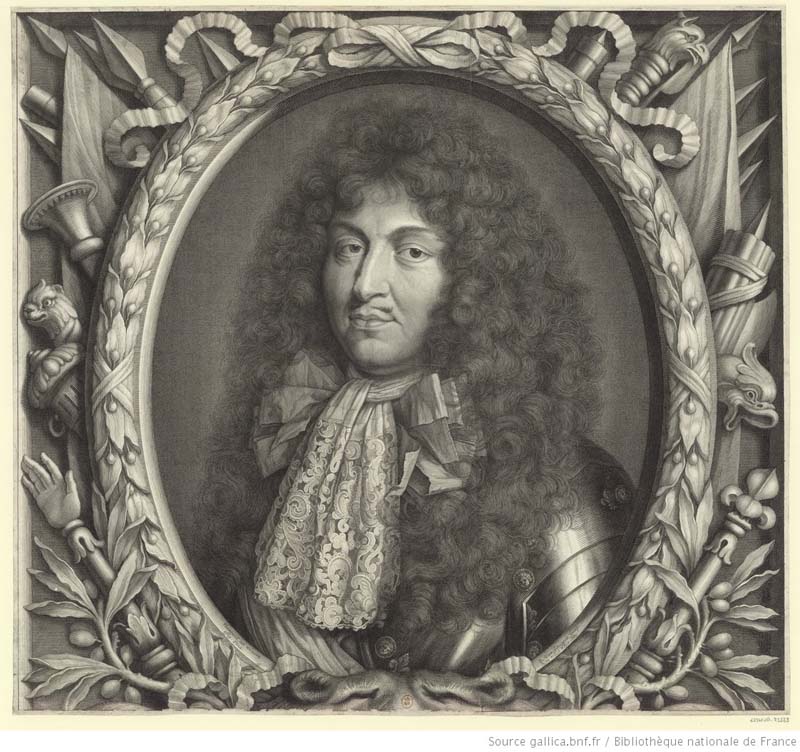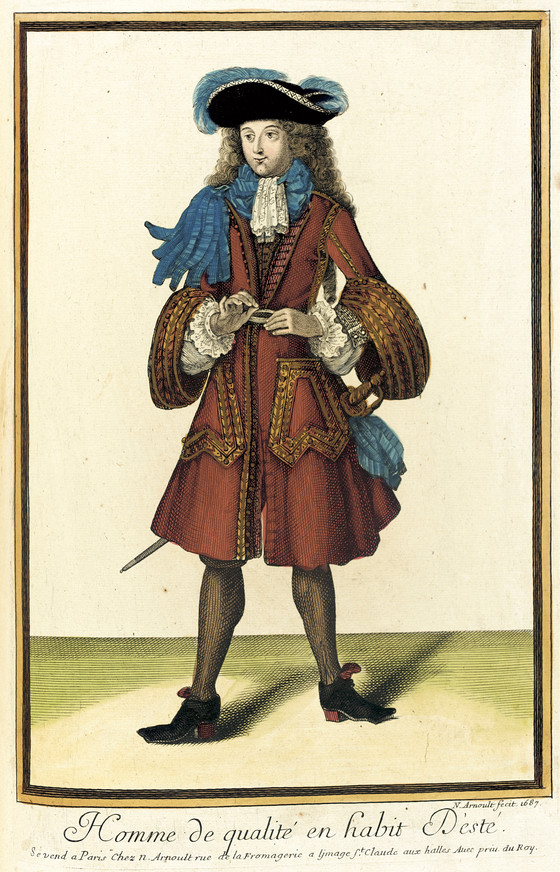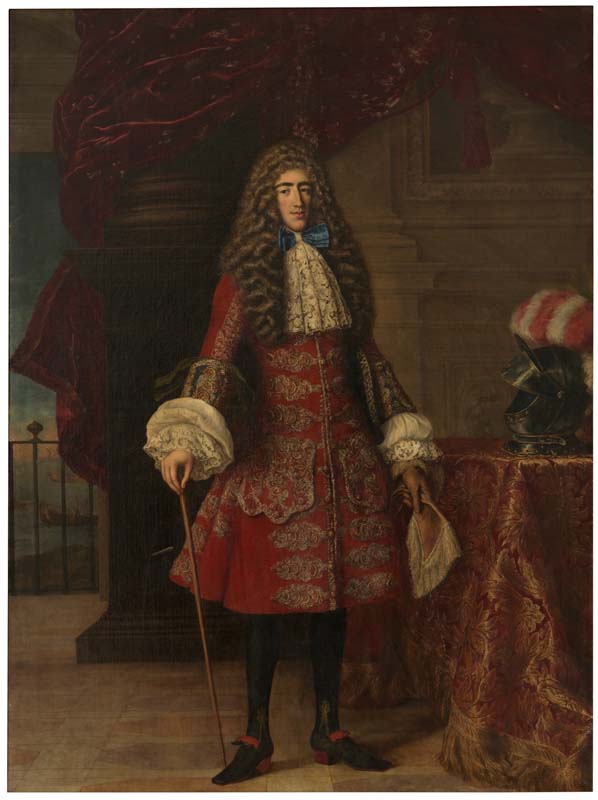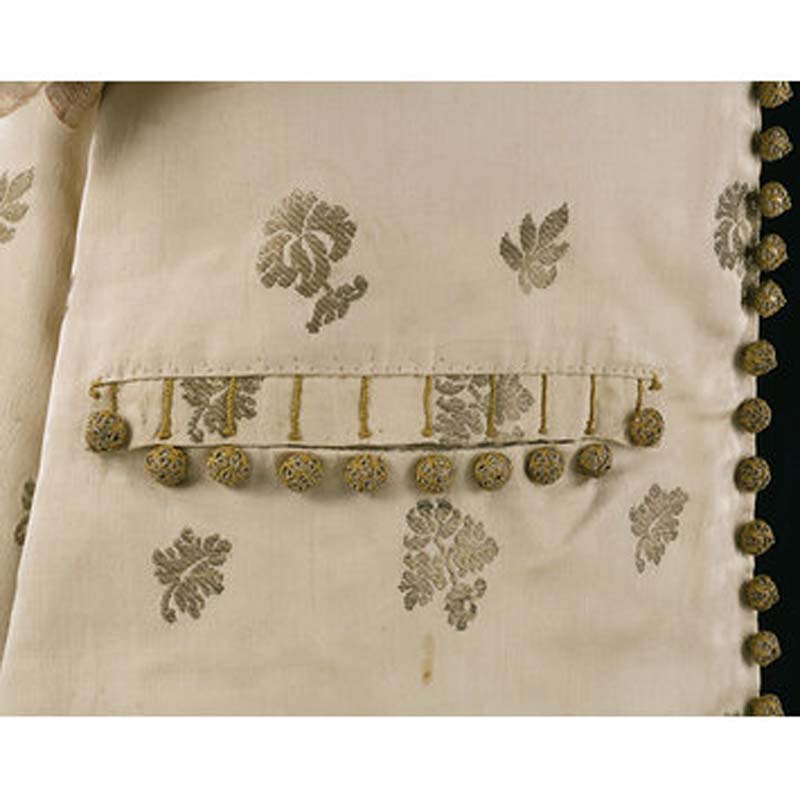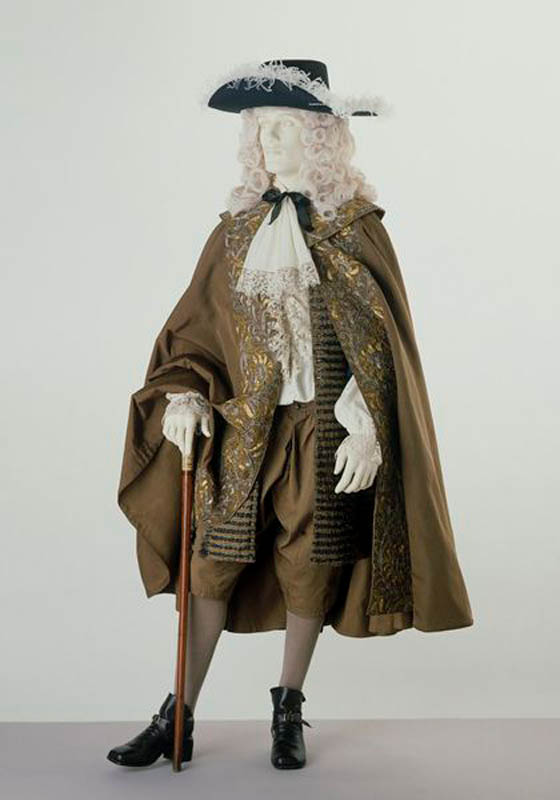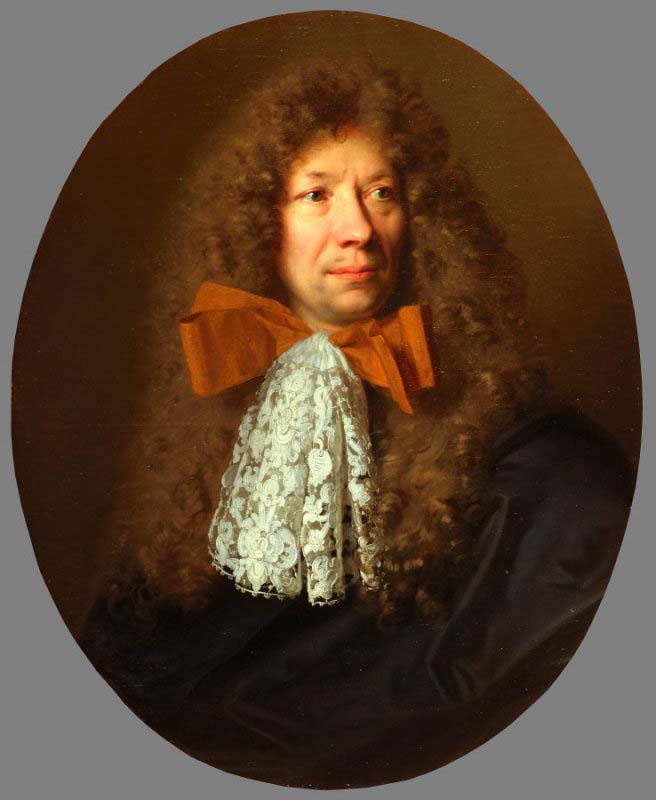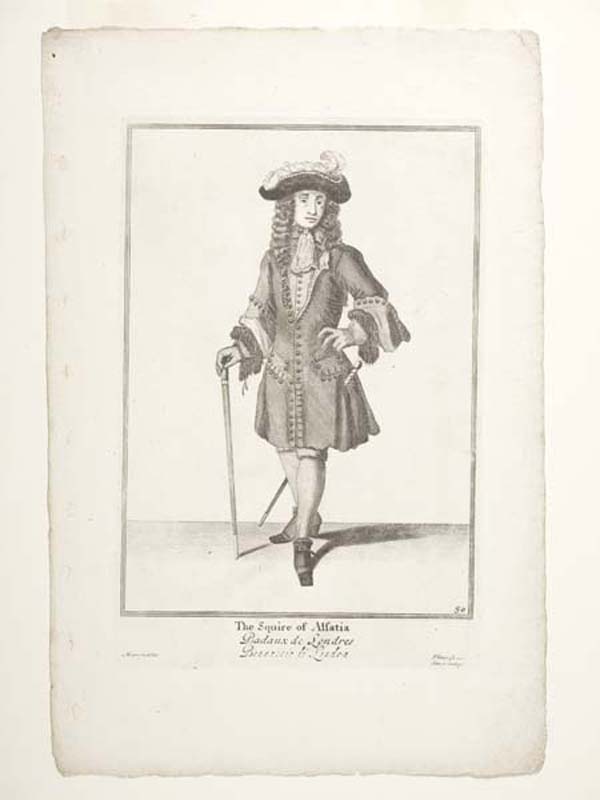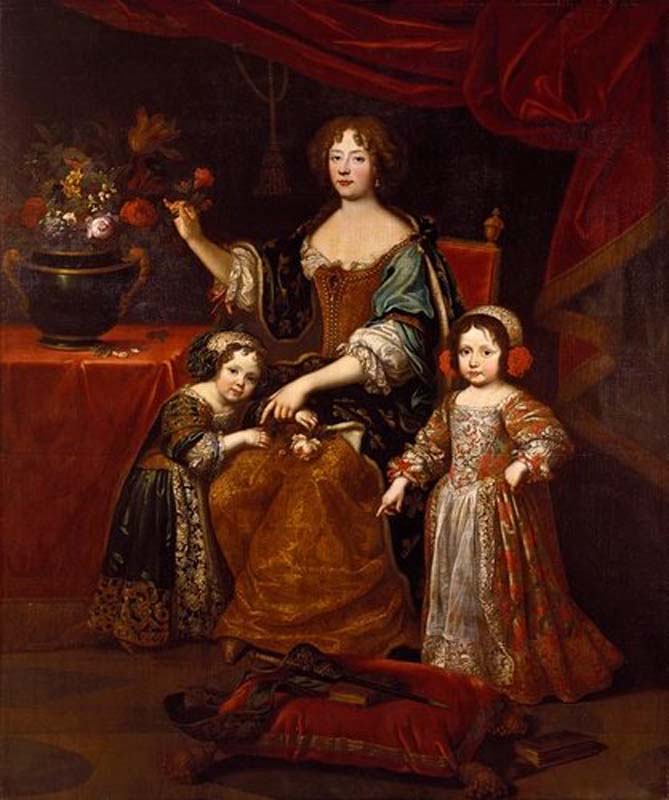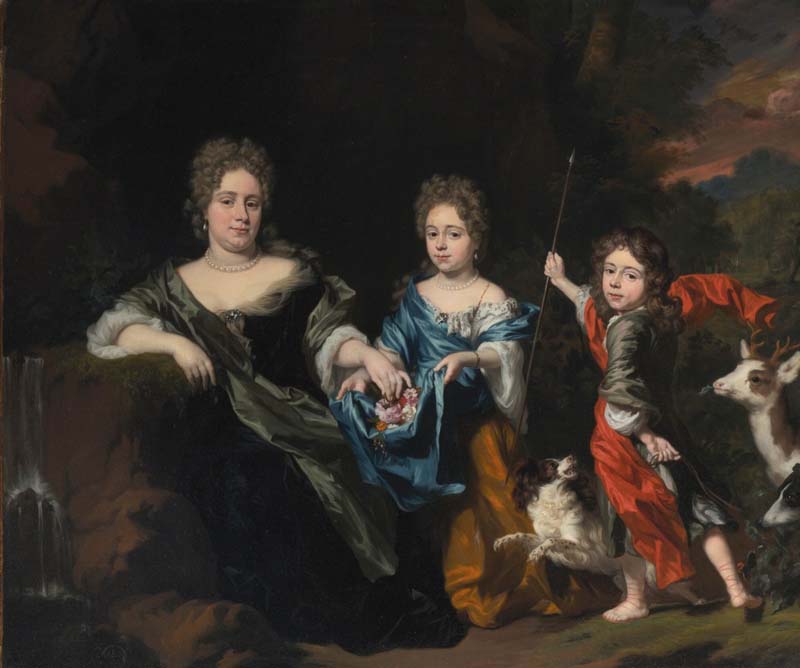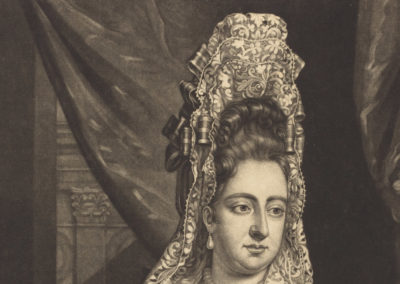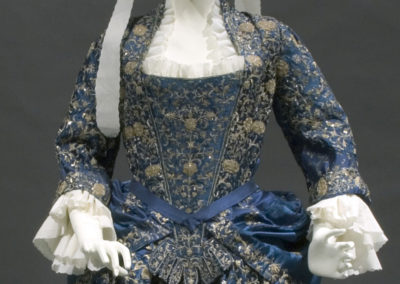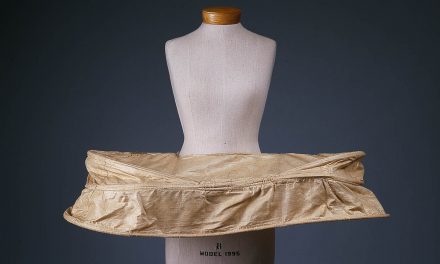OVERVIEW
In the 1680s, the bustled and trained mantua became the dominant dress for women, often in dark silk brocades. Men continued to wear the justaucorps, which was now slightly shaped at the waist, with a lace cravat and curly full-bottomed wig.
Womenswear
Women’s bodices in the 1680s slowly evolved to be less revealing and cover more of the shoulders (Hill 411). This trajectory toward modesty is often credited to Madame de Maintenon, who had secretly married French king Louis XIV in 1683 and exercised a wide influence at court (Davenport 519). The Cunningtons describe the overall silhouette of the decade in their Handbook of English Costume in the Seventeenth Century (1972):
“A close-fitting bodice joined to a full gathered and trained skirt, open in front. The corsage, fitting round the neck behind and cut square or round, was edged with a border which was brought forward over the shoulders to converge in a V at the waist, where it might be secured by a ribbon band or narrow belt. The V gap was filled in by an embroidered stomacher ending in a point at the waist…. the stomacher might be replaced by an embroidered corset.” (175)
Bodice sleeves became elbow-length with the ruffled cuffs of the chemise visible (Davenport 519). Long trains became fashionable for overskirts (Cunnington 174). Anna Josepha Monialis gives a good idea of this look in her portrait (Fig. 1), where she holds up part of her long train in her right hand. A surviving 1680s bodice and skirt, though not open in the front, includes a triangular stomacher covered in metallic lace on the front of the bodice (Fig. 2).
Fabrics became heavier and their colors darker in comparison to past decades, as Milia Davenport explains in The Book of Costume (1948): “light colors were supplanted by darker, with the metal and fringe-trimmed, heavily upholstered brocade gowns of Mme de Maintenon’s time” (519). Anna Josepha Monialis’s gown shows some of those rich textiles (Fig. 1) and dense decoration of metallic laces, Venetian lace and embroidery. Eleonore Magdalena of the Palatinate (Fig. 3) also wears a brocade gown with added gold metallic lace and silver embroidered decoration. An unknown young woman from Seville, Spain (Fig. 4) exhibits equally luxe textiles and lace embellishments.
Fig. 3 - Artist unknown (Austrian). Eleonore Magdalena (1655-1720) of Palatinate, ca. 1680. Oil on canvas; 108 x 83.5 cm. Berlin: Gemäldegalerie, Gemäldegalerie, 5617. Source: KHM
Fig. 4 - Cornelis Schut III (Flemish, 1629-85). Portrait of a lady, 1682. Oil on canvas; 126.3 x 98.8 cm (49¾ x 38 7/8 in). Private Collection. Source: Christie's
Fig. 5 - Nicolas Arnoult (French, 1671-1700). Recueil des modes de la cour de France, 'Femme de qualité en habit d'esté', 1687. Hand-colored engraving on paper; 36.51 x 23.81 cm (14 3/8 x 9 3/8 in). Los Angeles: Los Angeles County Museum of Art, M.2002.57.69. Source: LACMA
Fig. 6 - Nicolas Arnoult (French, 1671-1700). Recueil des modes de la cour de France, 'Femme de qualité en habit D'esté', 1687. Hand-colored engraving on paper; 36.52 x 23.81 cm (14 3/8 x 9 3/8 in). Los Angeles: Los Angeles County Museum of Art, M.2002.57.68. Source: LACMA
Fig. 7 - Marcellus Laroon II (British, 1653-1702). Old Satten Old Taffety or Velvet, 1688. Etched and engraved paper; 24.8 x 16.4 cm. London: The British Museum, L,85.22. Bequeathed by Sir Hans Sloane. Source: British Museum
At the same time, “striped materials remained popular often arranged in vertical and horizontal combinations” (Cumming 122). You can see two examples of the use of horizontal and vertical striping in two costume prints from the French court (Figs. 5-6).
Due to the richness and expense of the brocade fabrics and heavy silks then worn, there was a large secondhand market for fabrics (Cumming 128). A 1688 print from the bound series the “Cries of London” shows a fabric seller with the caption “Old Satten Old Taffety or Velvet” (Fig. 7). Her dress gives us a good idea of what everyday women in the period would be wearing, from her more conservative bodice and practical raised petticoat paired with an apron to her “traditional conical crowned, wide-brimmed hat of the lower classes, over her plain hood” (Cumming 128).
In 1685, Louis XIV revoked the Edict of Nantes which had ensured religious toleration in France for Protestants. This prompted many Protestant silk weavers to emigrate to England, which bolstered the English silk industry in Spitalfields (Waugh Men 56).
The 1680s also witnessed the rise of the mantua:
“new form of gown … featured a construction in one length from the shoulder seam to the skirt hem. The sides of the gown’s open-front skirt were pulled back upon the hips to form a bustle effect with a cascading train in the back. The exposed underskirt was often lavishly embellished with all types of trim and decoration.” (Hill 412)
The name is thought to have originated due to an association with Mantua, Italy, which had a thriving silk industry (Cunnington 176). Norah Waugh explains slightly different terminology used in France, where “it was also called a mantua, or manteau, but in its early phase it was usually referred to as a robe de chambre” (Women 65). Many of the images already discussed feature mantuas (Figs. 1, 3, 5-6), but an 1689 Italian costume print (Fig. 8) offers another example and an important hint of the more modest, jacket-style mantuas that will become common in the 1690s.
The bustling effect of the mantua, which was also used when separate bodices and skirts were worn, meant that the underskirt gained in importance as it was now so prominent (Davenport 519).
Rich contrasting brocade underskirts (Figs. 1, 9) were sometimes paired with the mantua and as François Boucher explains in A History of Costume in the West:
“From 1680 on, ornaments and trimming became more numerous: skirts and bodice fronts were covered with passementerie and embroidery and were dotted with ribbon bows.” (258-59)
The blue striped mantua in figure 6 features contrasting red bows in a line down the front of the stomacher. A drawing of a French woman (Fig. 9) shows ample red ribbon loops on her chemise cuffs.
As the overall silhouette narrowed, women’s hairstyles took on added height as well. The fontange, a tall tiered lace headdress, became a dominant style. Boucher explains its origin and evolution:
“Towards 1678, the fontanges hairstyle appeared. Originally a simple bow lifting the curled hair to the top of the head, it was transformed into a complex scaffolding of locks completed with a cap that crowned the head in a veritable architecture of muslin, lace and ribbons mounted on brass wire.” (262)
See an example from 1687 in figure 10 and others above (Figs. 5, 6, 8); note the woman doing needlework at home is dressed informally (Fig. 10) and wears a pinafore. The fontange became pervasive by the end of the decade as Madame Duchesse d’Orléans, lamented in her correspondence in 1687:
“It is not surprising that you are wearing fontanges because everybody here does from little girls seven years old to old women in their eighties, the only difference is that young people wear them in all colours, whereas their elders have only black or dark-coloured ones.” (quoted in Waugh Women 112)
Women were not often painted wearing fontanges, so our best evidence of them comes in costume prints and fashion drawings. From the prints we can also see that women’s shoes in the period seem to come to a thin blunt point.
In addition to the still-omnipresent pearl necklaces and pearl drop earrings (Fig. 11), a new trend in accessories appeared, namely the black patch:
“Tiny black patches made of satin, velvet, or leather were glued to face as beauty marks. Shapes ranged from simple dots to ornate stars, crescent moons, and hearts.” (Hill 414)
Again in the 1680s these patches were rarely worn in portraits, but feature in all the fashion prints of the period (Figs. 5-6, 8-10).
Fig. 8 - Arnold van Westerhout (Italian, 1651-1725). French Lady dressed as a Sultana with a fan, 1689. Hand-colored engraving. London: Victoria and Albert Museum, E.21583-1957. Given by the House of Worth. Source: V&A
Fig. 9 - Roger de Gaignieres (French, 1641-1715). Portrait de dame en grand costume, late 17th century. Watercolor. Paris: National Library of France. Source: Gallica
Fig. 10 - Nicolas Arnoult (French, 1671-1700). Recueil des modes de la cour de France, 'Femme de qualité, en d'eshabillé d'Esté', 1687. Hand-colored engraving on paper; 36.51 x 23.81 cm (14 3/8 x 9 3/8 in). Los Angeles: Los Angeles County Museum of Art, M.2002.57.116. Source: LACMA
Fig. 11 - Jan van Haensbergen (Dutch, 1641-1705). Portrait of a Lady, 1680. Oil on canvas; 56.4 x 46.3 cm. Private Collection. Source: Christie's
Fig. 12 - Pierre Mignard (French, 1612-95). Louise de Kéroualle, Duchess of Portsmouth, 1682. Oil on canvas; 120.7 x 95.3 cm (47 1/2 x 37 1/2 in). London: National Portrait Gallery, NPG 487. Source: NPG
Pale white skin was highly desirable and led some women to choose to pose next to Black servants or enslaved people to create a contrast. Louise de Kéroualle, Duchess of Portsmouth, (Fig. 12) and mistress of English king Charles II provides perhaps the most striking example of this abhorent trend. The National Gallery comments:
“The child’s dark skin marks a stark contrast from the fairness of the duchess, the careful juxtapositioning of the sitters serves to further emphasise the whiteness of the duchess’s complexion. Ideas on beauty and class prevalent in Europe at the time would have considered the palest complexions to be the most beautiful and an indicating factor of the person’s class also. In the 17th and 18th Centuries both men and women resorted to artifice to make their complexions even whiter as a result.”
The unknown woman painted by Jan van Haensbergen (Fig. 11) and Louise de Kéroualle both wear gowns fastened by clasps at the center front. As their portraits are from earlier in the decade they still have the plunging nearly off-the-shoulder necklines of the 1670s.
Fashion Icon: Louis XIV, King of France
One regulation that had far-reaching consequences mandated that textile designers produce new designs and textiles twice a year, thus creating the modern fashion “season.” This created a pressure to innovate in terms of designs producing new patterns, new colors and new styles every six months, but it also drove consumption as it forced everyone who wished to remain fashionable to renew their wardrobe seasonally (Chrisman-Campbell).
Fig. 1 - Claude-Guy Hallé (French, 1652-1736). Louis XIV receiving the Doge of Genoa at Versailles on 15 May 1685, following the Bombardment of Genoa, 1715. Oil on canvas; 343 x 603 cm. Versailles: Palace of Versailles, MV 2017. Source: Versailles
Louis XIV had helped popularize the justaucorps in the 1660s and was responsible for other trends as well, most notably for red heels on shoes. As Rebecca Shawcross explains in Shoes: An Illustrated History (2014):
“Louis XIV was personally responsible for several trends during this period, including … the adoption of the red heel and sole…. Louis’s heels were covered in red Morocco leather or painted that colour. At times the King also wore heels painted with landscapes, battle scenes and – it has been suggested, risqué portraits.” (60)
The signature red heels can be seen in a painting of Louis XIV receiving the Doge of Genoa at Versailles on 15 May 1685 (Fig. 1) on both Louis XIV, the Dauphin (his son) at his left, and the courtier in the foreground. That courtier seems to wear the blue justaucorps with red accents that Louis XIV had established as a form of court costume in the 1660s.
Fig. 2 - Pierre Rabon (attributed) (French, 1619-84). Portrait of Louis XIV, 1680s. Oil on canvas; 85.5 x 64 cm (33.7 x 25.2 in). Private Collection. Source: Auction France
Fig. 3 - Pierre Louis Van Schuppen (Flemish, 1627-1702). Portrait of Louis XIV, 1681. Engraving; 58.1 x 64.1 cm. Paris: National Library of France. FRBNF44489618. Source: Gallica
Fig. 4 - René-Antoine Houasse (French, c. 1645-1710). Louis XIV on horseback, King of France and Navarre (1638-1715), ca. 1679-90. Oil on canvas; 255 x 200 cm. Versailles: Palace of Versailles, MV 2109. Source: Versailles
By the 1680s Louis XIV had also adopted the wearing of a full-bottomed wig that came to two very high peaks (Fig. 2). During his reign France was often at war, so many portraits show Louis XIV in armor as in figures 2 and 3, though paired with a wig and fashionable lace cravat backed by a large red satin ribbon bow. A portrait of Louis XIV on horseback shows the new narrower breeches then worn (Fig. 4), as well as an early version of the tricorne hat. By centering aristocratic life at the court at Versailles, Louis XIV consolidated the power of the monarchy as currying favor with the King meant not only acting but dressing as he desired–in the latest Lyons silks. The effects of Louis XIV’s reorganization and promotion of the French fashion industries would outlast even his own very long reign.
Menswear
Louis XIV’s marriage to Mme de Maintenon also affected fashionable trends in menswear as Boucher explains:
“After the King’s [Louis XIV] marriage to Madame de Maintenon, a note of gravity was to be added, and La Bruyère noted its effects in 1682: ‘Formerly a courtier had his own hair, wore doublet and breeches and wide cannons and was a libertine. This is no longer in favour: now he has a wig, a tight suit and plain stockings and he is fervently religious.’” (260)
A hand-colored costume print from 1687 gives a good impression of the overall effect (Fig. 1). Boucher elaborates further: “now long, severe, buttoned justaucorps, tight breeches and dark stockings were worn; gone was lace, except on the cravat and sleeves; gone were plumes, except for hats and, rarely, as edgings.” (260)
The Duke of Medinaceli (Fig. 2) models the long buttoned justaucorps and dark stockings, with lace only at the cravat and cuffs.
Justaucorps remained knee-length, but their cut became slightly more shaped with an emphasis on the waist (Cunnington 136). In Anton Domenico Gabbiani’s depiction of three white musicians at the Medici Court (Fig. 3), we can see this new waist emphasis particularly in the case of the seated man. While the Black young man at the right goes unmentioned in the work’s title, he also wears a version of the justaucorps, but in an eye-catching silver brocade fabric and without the shirt cuffs and lace cravat worn by the other men. He instead wears a silver collar, which likely refers to his enslaved status, and holds a parrot—both were likely included in the picture as an indication of wealth and status as was common in 17th-century portraiture (Baetjer).
Braid or metallic lace trim became the dominant form of decoration on the justaucorps, often arranged at the coat’s seams and edges (Waugh Men 55) as it was in the fashion print (Fig. 1) and the duke’s coat (Fig. 2).
Fig. 1 - Nicolas Arnoult (French, 1671-1700). Recueil des modes de la cour de France, 'Homme de qualité en habit D'esté', 1687. Hand-colored engraving on paper; 36.51 x 23.81 cm (14 3/8 x 9 3/8 in). Los Angeles: Los Angeles County Museum of Art, M.2002.57.107. Purchased with funds provided by The Eli and Edythe L. Broad Foundation, Mr. and Mrs. H. Tony Oppenheimer, Mr. and Mrs. Reed Oppenheimer, Hal Oppenheimer, Alice and Nahum Lainer, Mr. and Mrs. Gerald Oppenheimer, Ricki and Marvin Ring, Mr. and Mrs. David Sydorick, the Costume Council Fund, and member of the Costume Council. Source: LACMA
Fig. 2 - Jacob-Ferdinand Voet (Flemish, 1639-89). Luis Francisco de la Cerda, IX Duke of Medinaceli, ca. 1684. Oil on canvas; 231 x 173 cm. Madrid: Prado Museum, P002561. Source: Prado
Fig. 3 - Anton Domenico Gabbiani (Italian, 1652-1726q). Portrait of Three Musicians of the Medici Court, ca. 1687. Oil on canvas; 141 x 208 cm (55.5 x 81.8 in). Florence: Galleria dell'Accademia. Source: Wikipedia
Fig. 4 - Jean Dieu de Saint-Jean (French, 1654-95). Homme de qualité en habit garny de rubans, 1689. Engraving; 29 x 19 cm. Paris: National Library of France, FRBNF41097186. Source: Gallica
Fig. 5 - Designer unknown (British). Coat and Breeches, ca. 1680. Silk, hand woven and hand sewn, silver, gold. London: Victoria and Albert Museum, 175-1900. Source: V&A
In the 1680s it became fashionable to have four vertical pockets on the justaucorps (Fig. 4), though horizontal pockets were still seen (De Marly 58). Pockets often featured many small buttons and buttonholes but were typically left open making the buttons purely decorative. The Victoria & Albert Museum has a nice example of a coat where most of the buttonholes are nonfunctional (Fig. 5).
Diana De Marly describes the rest of a man’s look in Fashion for Men: An Illustrated History (1985):
“the vogue for ribbons persists. There are even bows of satin ribbon behind the cravat. Fringed gloves now oust embroidered ones. High-heeled shoes with tiny buckles complete the ensemble, and with the high periwig make a man several inches taller.” (58)
The “homme de qualité” in figure 1 shows the continuing enthusiasm for ribbons and ribbon-backed cravats, as does the other fashionable man in figure 4. Fringe-edged gloves appear in figures 2-4 and also in a portrait of James II by Anne Killgrew (Fig. 6). High-heeled shoes are omnipresent, including the red heels popularized by Louis XVI (Fig. 2), but buckles are not nearly as prominent as in previous decades.
Shirts and waistcoats remained visible under the justaucorps as it was sometimes left unfastened (Fig. 6). The 1688 Verney memoirs stress this in an urgent shopping request:
“I hope you will consider to buy me some good shirts or else some sort of waistcoat for summer ffor [sic] it is not fashionable for any gentleman to go Buttened [sic] up either summer or winter, but especially summer.” (Cunnington 139)
Breeches were rarely seen under the long waistcoat and justaucorps and over the course of the decade they narrowed considerably (Boucher 258). They now often finished in close-fitting cuffs or knee bands (Hill 404). A pair of wool breeches in the Victoria & Albert museum (Fig. 7) are considerably narrower and plainer than those of previous decades.
Fig. 6 - Anne Killigrew (British, 1660-85). James II (1633 - 1701), 1685. Oil on canvas; 104.7 x 86.4 cm. Northern Ireland: Hillborough Castle, RCIN 403427. Source: Royal Collection Trust
Fig. 7 - Designer unknown (British). Coat and Breeches, ca. 1680. Worsted wool, trimmed with black silk and silver-gilt thread braid, faced and lined with blue wool, hand-sewn. London: Victoria and Albert Museum, 191&A-1900. Source: V&A
Fig. 8 - Nicolas de Largillière (French, 1656-1746). Portrait of a Gentleman (Pierre Van Schuppen?), 1680. Oil on canvas; 72.4 x 59 cm (28 1/2 x 23 1/2 in). San Francisco: Fine Arts Museums of San Francisco, 1961.23. Source: FAMSF
Most men gave up facial hair preferring to appear clean-shaven (Davenport 518), but large full-bottomed wigs remained the standard, as mentioned above (Fig. 8). Daniel Delis Hill describes the look of the wig and the origin of the word periwig in the History of World Costume and Fashion (2011):
“Through the early 1680s, wigs were a mass of loose, irregular curls that fell low over the shoulders. In England, these were called periwigs, from the French word ‘perruque,’ meaning head of hair. The crowns were flat, usually with a casual treatment of the forelocks or bangs. From the mid-1680s into the eighteenth century, the crowns of wigs gradually increased in height and became longer and fuller with locks extending halfway down the torso in the front and back. These became known as full-bottomed wigs.” (406).
With such high wigs in vogue, hats were less frequently worn (Figs. 1, 9) and often instead carried under the arm. The crown of hats became lower, making them easier to hold under the arm (Boucher 262). At the same time the wide brims were raised, often on three sides in a forerunner of the soon-to-be-dominant tricorne hat (Fig. 1) (Hill 405).
A man’s look was completed with a few other essential accessories; foremost among them, the lace cravat cinched with a ribbon bow (Figs. 1-4, 8). Bullion-fringed gloves (Figs. 2-4, 6), walking sticks (Figs. 2, 7, 9) and swords (Figs. 1, 4, 9) were also commonly seen, baldricks (Fig. 4) and sashes were less common than in previous decades (Cumming 126).
At home men would remove their justaucorps and wear looser patterned silk robes, though still with their cravats, as you can see in Jacob Ferdinand Voet’s portrait of an unknown young nobleman (Fig. 10).
This of course has been a description of fashionable dress. Everyday men dressed rather differently and commentators at the time played up the discrepancy. The 1685 Factious Citizen explained to a fop how to pass as an ordinary citizen:
“Off with your clothes, your sword, wig and hat, put yourself nimbly into the a suit of black grogram below the knee, a broad-skirted doublet, a girdle about the middle, a short black cloak squirted down before with black taffety; a broad-brim’d hat, with a great twisted hat-band, with a rose at the end of it. Your hair is slink enough, and of precise cut, without your periwig.” (Cunnington 168-69)
Fig. 9 - Artist unknown (British). The Squire of Alsatia, 1688. Paper, ink; 33.5 x 22.3 cm. London: Museum of London, 2002.139/330. Source: MoL
Fig. 10 - Jacob Ferdinand Voet (Flemish, 1639-89). Unknown Young Nobleman, 1680s. Oil on canvas; 69.4 x 55.6 cm (27 3/4 x 22 1/4 in). London: Weiss Gallery. Source: tumblr
CHILDREN’S WEAR
As in previous decades, infants and babies were dressed in white gowns. Toddlers of both genders were dressed in gowns of different colors and patterns (Fig. 1). Elite children even wore silks and lace as in the portrait of Elizabeth Charlotte, Princess Palatine (Fig. 1) and her son and daughter. Both children are dressed in silk brocade gowns with what appears to be Venetian lace trimmed pinafores. As Anna Reynolds describes in In Fine Style: The Art of Tudor and Stuart Fashion:
“she and her two children are depicted at the height of fashion, wearing luxurious silk woven with gold thread and lace in the style of Venetian gros point.” (212)
Older children of age 5 or 6 would be dressed in a similar fashion to their parents. Children’s portraits in some cases followed the conventions of their parents’ as well, as we can see in Caspar Smits portrait of John Arundell VIII, 3rd Baron Arundell of Trerice, which shows him alongside a likely enslaved Black companion (Fig. 2). The white boy’s outfit oddly features bare legs under his fringed coat, making it a departure from everyday dress when stockings would have been worn. Nicolaes Maes’ portrait of a mother and two children in a park (Fig. 3) similarly features costume-like dress with classical-style draperies and even Roman sandals on the young boy.
Fig. 1 - Pierre Mignard (after) (French). Elizabeth Charlotte, Princess Palatine, Duchess of Orléans, with her son Philippe, later Regent of France, and daughter, Elizabeth, later Duchess of Lorraine, ca. 1678-88. Oil on canvas; 204.4 x 171 cm. Windsor: Queen's Presence Chamber, Windsor Castle, RCIN 404410. Source: RCT
Fig. 2 - Caspar Smits (Dutch, c. 1635-1707). John Arundell VIII (1678–1706), 3rd Baron Arundell of Trerice, as a Boy, 1680s. Oil on canvas; 64.5 x 52 cm. Cornwall: National Trust, Trerice, 337182. Source: ArtUK
Fig. 3 - Nicolaes Maes (Dutch, 1634-93). Portrait of a Mother and Two Children in a Park, ca. 1687-93. Oil on canvas; 57.1 x 48.3 cm (22.4 x 19 in). Private Collection. Source: Sothebys
References:
- Baetjer, Katharine. “Finding Context for a 17th-Century Enslaved Servant in a Painting by Largillierre.” The Metropolitan Museum of Art. Accessed July 17, 2020. https://www.metmuseum.org/blogs/now-at-the-met/2016/17th-century-enslaved-servant.
- Boucher, François, Yvonne Deslandres, and John Ross. A History of Costume in the West. London: Thames and Hudson, 1997. http://www.worldcat.org/oclc/443676264.
- Chrisman-Campbell, Kimberly. “King of Couture: How Louis XIV Invented Fashion as We Know It.” The Atlantic, September 1, 2015. https://www.theatlantic.com/entertainment/archive/2015/09/the-king-of-couture/402952/.
- V and A Collections. “Coat and Breeches | V&A Search the Collections,” July 14, 2020. http://collections.vam.ac.uk/item/O127178.
- Cumming, Valerie. A Visual History of Costume: The Seventeenth Century. 3. London: Batsford, 1984. http://www.worldcat.org/oclc/9761398.
- Cunnington, C. Willett, and Phillis Emily Cunnington. Handbook of English Costume in the Seventeenth Century. Boston: Plays, Inc, 1972. http://www.worldcat.org/oclc/755269282.
- Davenport, Millia. The Book of Costume. New York: Crown Publishers, 1948. http://www.worldcat.org/oclc/922657048.
- De Marly, Diana. Fashion for Men: An Illustrated History. London: B.T. Batsford Ltd, 1985. http://www.worldcat.org/oclc/752978274.
- Hill, Daniel Delis. History of World Costume and Fashion. Upper Saddle River, NJ: Pearson Prentice Hall, 2011. http://www.worldcat.org/oclc/768100950.
- “Louise de Kéroualle, Duchess of Portsmouth – National Portrait Gallery.” Accessed July 16, 2020. https://www.npg.org.uk/collections/search/portrait/mw05102/Louise-de-Kroualle-Duchess-of-Portsmouth.
- Reynolds, Anna. In Fine Style: The Art of Tudor and Stuart Fashion. London: Royal Collection Trust, 2013. http://www.worldcat.org/oclc/824726826.
- Shawcross, Rebecca. Shoes: An Illustrated History. London: Bloomsbury, 2014. http://www.worldcat.org/oclc/890162083.
- Waugh, Norah. The Cut of Men’s Clothes, 1600-1900. New York: Theatre Arts Books, 1964. http://www.worldcat.org/oclc/927414537.
- Waugh, Norah, and Margaret Woodward. The Cut of Women’s Clothes, 1600-1930. New York: Theatre Arts Books, 1968. http://www.worldcat.org/oclc/894728161.
Historical Context
Wikipedia: 1680-1689
Rulers:
- England
- Charles II (1660-1685)
- James II (1685-1688)
- Mary II (1689-1694)
- France: Louis XIV (1643-1715)
- Spain: Charles II (1665-1700)
1680 Danckerts Europe. Source: Lahaina Printsellers
Events:
- 1680 – Amsterdam opera at Leidsegracht opens.
- 1682 – The city of Philadelphia, Pennsylvania is founded by William Penn.
- 1682 – Newton’s theory of gravity.
- 1683 – Ottoman invasion halted at Vienna.
- 1685 – Louis XIV revokes the Edict of Nantes, forcing large numbers of Huguenots to seek refuge in London. Importing their silk-weaving expertise, these escapees helped found the Spitalfields silk industry.
- 1686 – The importation of chintz is banned in France (and 40 years later in England) to promote the interests of French and English wool mills.
- 1688 – The Nine Years’ War begins in Europe and America.
- 1688 – John Locke’s Glorious Revolution.
Primary/Period Sources
Resources for Fashion History Research
To discover primary/period sources, explore the categories below.
Have a primary source to suggest? Or a newly digitized periodical/book to announce? Contact us!
Primary/Period Sources
Secondary Sources
Also see the 17th-century overview page for more research sources… or browse our Zotero library.


